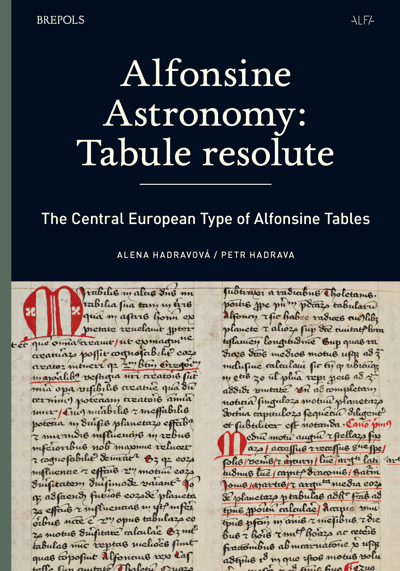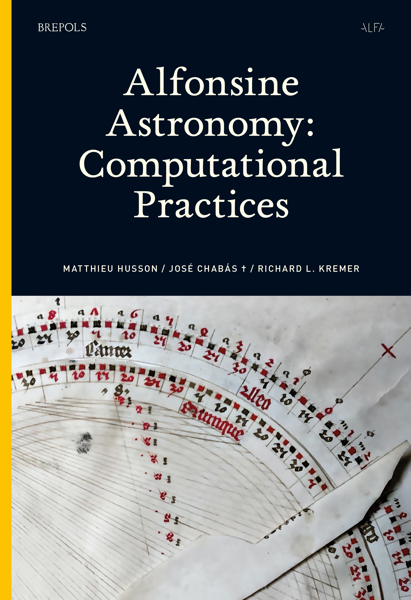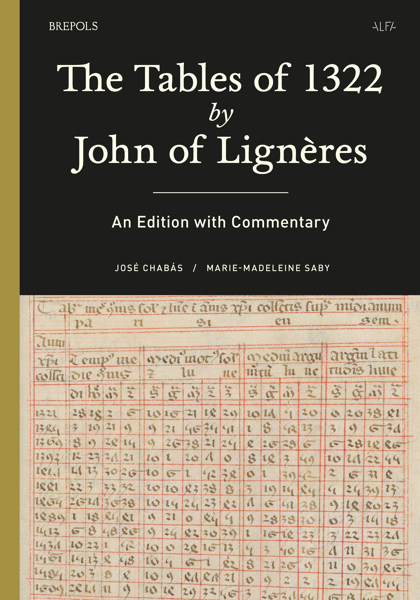
Alfonsine Astronomy: Computational Practices
Matthieu Husson, José Chabás, Richard Kremer (eds)
- Pages: 546 p.
- Size:178 x 254 mm
- Illustrations:38 b/w, 44 col., 27 tables b/w.
- Language(s):English, Latin
- Publication Year:2026
- € 90,00 EXCL. VAT RETAIL PRICE
- ISBN: 978-2-503-61077-1
- Hardback
- Forthcoming (Feb/26)
- ISBN: 978-2-503-61078-8
- E-book
- Forthcoming
*How to pre-order?
Unfolding more than two centuries of late mediaeval astronomers’ computational practices, this collective volume explores new venues in the history of astronomy.
Richard L. Kremer is emeritus professor of history at Dartmouth college and associate and reviews editor of the Journal for the history of Astronomy
Matthieu Husson is a researcher in the history of late medieval astronomy in Europe and is the PI of the ERC project ALFA based in Paris Observatory
José Chabás is emeritus professor at Pompey Fabra Universitat, Barcelona, and has authored several monographs on the history of astronomy
From the late thirteenth century, when Alfonsine astronomy began to take shape under Alfonso X’s patronage in Castille, to the first decades of the sixteenth century, when this astronomy had been a common tool of computation throughout Europe for almost two centuries, Alfonsine astronomers compiled all sorts of works on tables, instruments, procedures and theory which are now known in more than 900 manuscript codices, most of which were produced in the fourteenth and fifteenth centuries. These documents show that Alfonsine astronomers centred their activity around the elaboration of procedures, addressed to ever-growing audiences, rather than on theoretical speculations or celestial observations. These procedures were expressed by a complex web of procedural texts, tables, diagrams, and instruments and aimed at computing astronomical positions. Thus, the design and comparison of computational procedures for practitioners with different levels of mathematical skill was at the heart of many original works by Alfonsine authors.
Following the evidence of the sources, this volume thus focuses on computational practices broadly construed. To unfold the expanded meaning of ‘computation’ adopted in this book, the contributions are presented in four sections. A first group of chapters considers different examples of procedural texts oriented either towards table sets or instruments and analyses how astronomers might have embedded them with computational, geometrical, theoretical, or even historiographical meanings. The second series of chapters analyses tables or table sets and explores their geometrical and theoretical grounding as well as their purposes and numerical derivation. Contributions in the third section more specifically address questions directly related to numbers, accuracy, rounding and precision, or interpolation. The last set considers two common genres at the border between mathematical astronomy and its wider public: ephemerides and horoscopes.
Chap.1. Introduction
M. Husson, J. Chabás, R. Kremer
Part I: Procedural texts
Chap.2. A Note on Arabes maxime: A Testimony of Alfonsine Astronomers’ Interest in the Toledan Tables
E. Andriani, S. Gessner, N. Jacobson
Chap.3. Conrad Heingarter’s Treatise on Planetary Latitudes: An Introduction and Critical Edition
E. Andriani, C. Bui, N. Jacobson
Chap.4. The Planicelium of John Vimond: Edition, Translation, and Interpretation of a Text Describing an Astronomical Instrument from the Early Fourteenth Century
S. Gessner, M-M. Saby
Chap.5. Exempla in Figura in Alfonsine Canon Commentaries
N. Jacobson
Part II: Reconfiguring tables
Chap.6. Mathematical Treatment of Alfonsine Trepidation and its Sources
P. Hadrava
Chap.7. The Emergence of Auxiliary Astronomical Tables in Europe
G. Van Brummelen
Chap.8. Computing Solar and Lunar Velocities and Radii: The Table of John of Genoa and his Predecessors
J. Chabás and B. R. Goldstein
Chap.9. The Trigonometric Tables of Jean Fusoris (1365-1436)
J-C. Penin
Chap.10. Regiomontanus on the Equation of Time: Computational Practices of an Alfonsine Astronomer
E. Andriani, S. Zieme
Part III: Operating with numbers
Chap.11. Cyclical Radices in the Tabule resolute and their Adaptation to the Meridian of another City
A. Hadravová, P. Hadrava
Chap.12. Computational Practices in Alfonsine Astronomy: Hermann of Saxony’s Practica motuum planetarum
J. Chabás
Chap.13. Proportional Parts and Interpolation Practices in Alfonsine Astronomy: Unfolding Astronomers’ Works with a Mathematical Procedure
M. Husson
Part IV: On the border of mathematical astronomy
Chap.14. What Can We Learn about Computational Practices from a Study of Medieval Ephemerides?
R. L. Kremer
Chap.15. From Astronomical Computation to Astrological Interpretation: figurae caeli and ‘Astrological Squares’ in Fifteenth-Century Annual Prognostication
A. Tur



